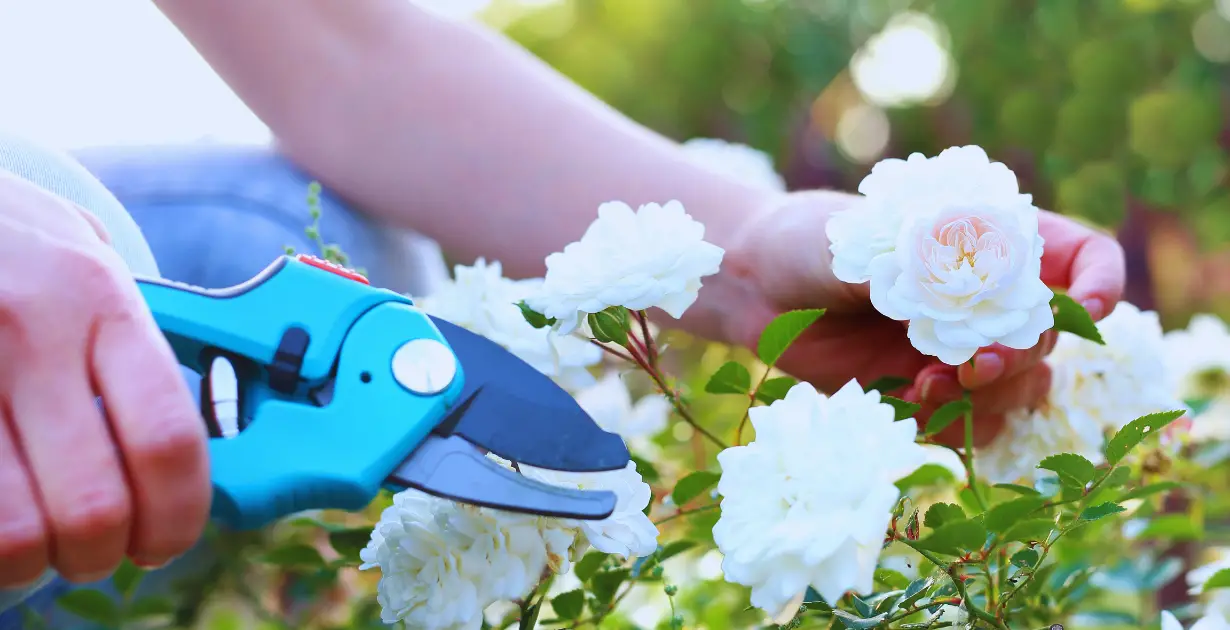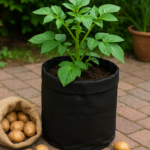Pruning rose bushes in winter is critical to ensuring lush, vibrant blooms come spring. When done correctly, winter pruning promotes healthier growth, improves the plant’s shape, and helps prevent diseases. While cutting back those beloved blooms may feel intimidating, winter is the perfect time for a trim. The plant’s dormant phase allows you to remove old, damaged, or excess branches without disturbing new growth, giving your roses a fresh start for the year ahead.
This guide will cover the essentials of winter rose pruning, from the best timing and techniques to tools and post-pruning care. Whether you’re an experienced gardener or just starting, these simple steps will help you prepare your roses for the colder months, ensuring they emerge solid and ready for spring. Let’s dive into the why and how of winter rose pruning, setting your garden up for a beautiful, fragrant season.
Importance of winter pruning for rose health and blooming

Winter pruning is essential for maintaining the health and vigor of rose bushes, preparing them for a burst of growth and abundant blooms in the spring. Here’s why winter pruning matters:
- Encourages Stronger Spring Growth
- By cutting back old, weak, or damaged branches, winter pruning redirects energy to healthier parts of the plant, promoting more robust growth in the spring.
- Improves Air Circulation and Reduces Disease
- Pruning thins out dense areas, allowing better air circulation. This reduces the risk of fungal infections, mildew, and other diseases that can thrive in crowded branches.
- Enhances Shape and Structure
- Pruning allows you to shape the rose bush for a balanced, open structure. This improves its appearance and helps sunlight reach all parts of the plant.
- Removes Damaged or Dead Wood
- Winter pruning clears out dead, damaged, or diseased wood, which can otherwise weaken the plant and invite pests.
- Promotes More Blooms
- Removing unnecessary branches helps the plant focus on producing more buds and blooms, leading to a more beautiful display come spring.
When to Prune Roses for Winter
Knowing when to prune roses for winter is critical to setting them up for success. Timing can vary depending on your climate, but generally, late winter is ideal.

Best Time for Winter Pruning Based on Climate
- Temperate Climates: In mild climates with minimal frost, prune roses in late winter, typically in January or early February. This is when the plant is still dormant but nearing the end of its rest period.
- Colder Climates: For areas with heavy frost, wait until the worst of winter has passed, usually in late February or early March. Pruning too early in these regions can leave the plant vulnerable to frost damage.
- Warmer Climates: In areas without a significant dormant season, you can prune as early as December, though light pruning might also be needed throughout the year.
Signs Your Rose Bushes Are Ready for Pruning
- Lack of Leaves: Roses typically shed most leaves by late winter, making it easier to spot dead or damaged wood.
- No New Growth: The rose bushes should still be dormant, with no signs of fresh green shoots or buds.
- Consistent Temperatures: Look for a consistent cold without sudden warm spells, which could trigger new growth too early.
Benefits of Pruning Roses in Winter
Pruning roses in winter offers several key benefits that help the plants grow stronger and bloom more beautifully in the spring. Here’s why winter pruning is beneficial:
- Encourages Healthy Spring Growth
- Winter pruning allows the plant to focus its energy on healthy branches, promoting vigorous new growth when spring arrives.
- Boosts Bloom Production
- By removing old or weak branches, the plant can allocate resources to produce more buds, resulting in a fuller display of flowers.
- Reduces Risk of Disease
- Pruning improves air circulation within the plant, reducing the chance of fungal diseases, which thrive in dense, moist areas.
- Improves Plant Structure
- Winter is a perfect time to shape your rose bushes. Remove awkward or crossing branches that may hinder growth, resulting in a balanced, attractive plant.
- Removes Damaged and Dead Wood
- Pruning out dead or damaged branches reduces pest infestations and minimizes the spread of disease.
- Prepares for Weather Conditions
- By cutting back long, heavy branches, you protect the plant from winter wind and snow damage and keep it sturdy through harsh conditions.
Types of Roses and Winter Pruning Techniques
Different roses benefit from specific winter pruning techniques, considering their unique growth patterns. Here’s how to approach winter pruning for various rose types:
Hybrid Tea Roses
- Characteristics: Hybrid tea roses are known for their large, single blooms on long stems.
- Pruning Technique: Cut back stems to about 12–18 inches above the ground, removing any dead or damaged wood. Keep 3–5 healthy canes and trim them at an angle just above outward-facing buds to encourage an open, vase-like structure.
- Purpose: This method maximizes air circulation and supports new, healthy growth in spring.
Shrub Roses
- Characteristics: Shrub roses are bushier and produce clusters of flowers, making them low-maintenance.
- Pruning Technique: Remove dead or weak wood, then lightly shape the plant by trimming the outer edges. Cut back about a third of the height, but avoid heavy pruning to preserve the natural form.
- Purpose: This keeps shrub roses full and encourages vigorous flowering without losing their shape.
Climbing Roses
- Characteristics: Climbing roses have long, arching canes and can be trained to grow along trellises or walls.
- Pruning Technique: Focus on removing dead or crossing branches, then trim the side shoots to about 2–3 buds from the main canes. Avoid cutting back the main canes, which support the plant’s structure and future blooms.
- Purpose: You support vertical growth by leaving main canes intact while encouraging lateral blooms.
Floribunda Roses
- Characteristics: Floribundas are known for their bushy shape and clusters of medium-sized blooms.
- Pruning Technique: Cut back stems to 6–12 inches above the ground, preserving 3–5 strong canes. Prune at a slight angle just above outward-facing buds to maintain an open structure.
- Purpose: This technique encourages balanced growth and prolific blooming throughout the season.
Miniature Roses
- Characteristics: Miniature roses are compact, with small leaves and blooms, making them suitable for containers.
- Pruning Technique: Lightly trim the plant, removing any damaged or dead wood and shape as needed. Avoid heavy pruning since miniature roses don’t need extensive cuts.
- Purpose: This keeps the plant tidy and encourages fresh blooms without disrupting its compact form.
Old Garden Roses (Heirloom Roses)
- Characteristics: Heritage varieties tend to have a more open, sprawling growth habit.
- Pruning Technique: Remove only dead, diseased, or damaged wood, with minimal cutting back. Shape as needed, but keep pruning light.
- Purpose: This helps preserve the natural shape and historic character, as heavy pruning can reduce flowering in heirloom varieties.
Tools Needed for Pruning Rose Bushes

1. Essential Tools for Effective Pruning
- Bypass Pruners: These are used to make clean cuts on thinner stems. Their scissor-like action is gentle on the plant.
- Loppers are ideal for thicker branches that are difficult to reach with pruners. They provide extra leverage, helping cut through sturdy wood.
- Pruning Saw: This tool is necessary for cutting large, woody stems. A small, sharp saw makes precise cuts without damaging the bush.
- Thick Gloves: Protects hands from thorns and sharp edges. Leather gloves offer excellent protection for working with roses.
- Disinfectant: Prevents the spread of disease by sterilizing tools between cuts.
2. Tool Maintenance Tips
- Clean After Use: Wipe tools with a damp cloth to remove sap and dirt, then dry thoroughly.
- Sharpen Blades: Keep pruners, loppers, and saws sharp to ensure clean, efficient cuts. Sharpen blades at the start of each season.
- Oil Metal Parts: Apply a thin layer of oil on metal parts to prevent rust, particularly after exposure to damp conditions.
Step-by-Step Guide to Pruning Roses for Winter
1. Safety Tips and Preparation
- Wear long sleeves, thick gloves, and eye protection to prevent injuries from thorns.
- Sterilize all tools before starting and between plants to avoid spreading diseases.
2. Removing Dead or Diseased Wood
- Start by inspecting the bush for dead or diseased wood, which usually looks black or brown, brittle, or damaged.
- Cut back any dead or diseased stems to the base or a healthy part of the stem, completely removing them from the bush.
3. Cutting Back Stems: How Much Is Too Much?
- Generally, aim to cut back one-third of the plant. For hybrid tea roses, cut stems to 12–18 inches; for floribundas, trim to about half their height.
- Avoid over-pruning, as it can weaken the plant. Leave 3–5 strong canes to encourage a robust structure.
4. Shaping and Thinning for Air Circulation
- Remove crossing or inward-growing branches, which can lead to overcrowding and reduced airflow.
- Aim for an open, vase-like shape to promote healthy growth and help prevent fungal diseases.
How to Protect Pruned Roses Through Winter
1. Mulching and Covering Rose Bushes
- Apply a 2–4-inch layer of mulch (such as straw, bark, or compost) around the base of the plant. Mulch acts as an insulator, keeping roots protected from temperature fluctuations.
- Consider covering the entire rose bush with burlap or a rose cone in very cold climates. This will allow the bush to breathe while shielding it from harsh winds.
2. Tips for Insulating Rose Roots
- Hill up soil around the base of the rose to about 8–12 inches, creating a mound that helps shield roots.
- Use mulch over this mound for extra insulation. Additional layers may be added in colder regions to keep roots safe from freezing as winter progresses.
Common Mistakes to Avoid When Pruning for Winter
When pruning roses for winter, it’s easy to make a few common mistakes that can impact the plant’s health and spring growth. Here’s what to avoid:
Pruning Too Early or Too Late
- Mistake: Pruning roses too early in the fall can trigger new growth and make them vulnerable to frost damage. Conversely, pruning too late may harm the plant as it prepares to leave dormancy.
- Solution: Wait until late winter when the plant is fully dormant and the risk of extreme cold has passed.
Over-Pruning
- Mistake: Cutting back more than a third of the plant’s total growth can weaken it, leaving it vulnerable to stress and disease.
- Solution: Aim to remove only about one-third of the bush, preserving solid and healthy canes.
Leaving Diseased Wood on the Plant
- Mistake: Failing to remove diseased or damaged wood can spread infection in the plant.
- Solution: Cut back to healthy wood and remove branches showing signs of disease, such as discoloration or brittleness.
Cutting at the Wrong Angle
- Mistake: Flat cuts can encourage water to collect on the cut surface, increasing the risk of rot.
- Solution: Always prune at a 45-degree angle above an outward-facing bud to encourage healthy new growth and prevent water from sitting on the cut.
Ignoring Aftercare Steps
- Mistake: Not applying mulch or protecting pruned bushes leaves roots exposed to cold damage.
- Solution: After pruning, add a layer of mulch around the base and consider extra winter protection, especially in cold climates.
Post-Pruning Care for Rose Bushes
Proper post-pruning care is essential for keeping your rose bushes healthy and ready for an intense spring bloom. Here’s what to focus on after winter pruning:
- Apply Mulch for Insulation
Add a 2–4 inch layer of organic mulch, such as compost, bark, or straw, around the base of the rose bush. This helps insulate roots from extreme temperature fluctuations and keeps the soil moist through the winter.
- Watering After Pruning
Give your roses a deep watering right after pruning, especially if the soil is dry. While roses don’t need much water during dormancy, a good soak helps them settle in for the winter.
- Inspect for Pests or Disease Signs
Look over the pruned rose bush for any lingering signs of pests or disease. If spotted, remove affected branches and keep the area around the plant clean to prevent pest infestations.
- Add a Light Layer of Fertilizer (If Recommended)
In early spring, apply a balanced, slow-release fertilizer around the base of the rose bush. This gives the plant a gentle nutrient boost as it comes out of dormancy. Avoid fertilizing right after pruning to prevent premature growth.
- Monitor for Any New Growth
Keep an eye on your roses throughout winter to ensure no new growth is exposed to frost. If temperatures fluctuate, add extra mulch or cover the plant with burlap in severe cold.
How Pruning in Winter Differs from Spring Pruning
Pruning roses in winter and spring involves different techniques and purposes, reflecting the unique needs of the plants during these seasons. Here’s a breakdown of how winter pruning differs from spring pruning:
Timing and Plant Dormancy
- Winter Pruning occurs while the plant is fully dormant, usually between late winter and early spring (January to March, depending on the climate). Pruning at this time minimizes stress and allows for clean cuts without disrupting new growth.
- Spring Pruning: Typically performed as the plants awaken from dormancy, spring pruning (often in March or April) targets fresh growth and is done when new buds swell.
Goals and Objectives
- Winter Pruning: The primary goal is to shape the bush, remove dead or diseased wood, and encourage robust growth by directing the plant’s energy to healthy canes. It sets the foundation for the coming growing season.
- Spring Pruning: Focuses on refining the plant’s shape, removing any frost-damaged wood from winter, and encouraging new growth. It can also involve cutting back vigorous shoots to balance the plant and promote blooming.
Types of Cuts
- Winter Pruning: Generally involves more severe cuts to reshape the bush and remove significant portions of old wood. Cuts are made at a 45-degree angle just above healthy buds, promoting outward growth.
- Spring Pruning involves lighter cuts, focusing on thinning out excess growth, removing dead or weak branches, and fine-tuning the overall shape. The emphasis is on maintaining balance rather than heavy reductions.
Pest and Disease Management
- Winter Pruning: Reducing overcrowding and removing dead wood helps reduce the risk of disease and pests before spring growth begins.
- Spring Pruning: Inspecting for winter damage and diseases is crucial, as new growth can be more susceptible to pests. This is an opportunity to make adjustments based on the plant’s health and any issues during winter.
Tools and Techniques
- Winter Pruning: Requires sharp tools like bypass pruners, loppers, and saws to make clean cuts on dormant wood. It’s a more aggressive pruning session.
- Spring Pruning: Typically involves lighter, more precise tools and techniques. You may still use pruners and loppers, but the emphasis is on careful cuts that maintain the plant’s integrity.
Tips for Pruning Roses in Winter
- Know Your Rose Type
- Familiarize yourself with the type of rose you are pruning (hybrid tea, floribunda, climbing, etc.), as each type has its own pruning requirements and timing.
- Choose the Right Time
- Aim to prune in late winter, typically between January and March, depending on your climate. Wait until the worst of winter has passed, but before new growth begins.
- Use Sharp, Clean Tools
- Ensure your pruning tools are sharp and clean to make precise cuts. This reduces the risk of disease and damage to the plant. Disinfect tools with rubbing alcohol or a bleach solution between cuts.
- Wear Protective Gear
- Wear thick gloves, long sleeves, and eye protection to protect yourself from thorns. This makes the pruning process safer and more comfortable.
- Remove Dead and Diseased Wood
- Start by cutting out any dead, damaged, or diseased branches. Look for blackened or brittle stems and cut them back to healthy wood to prevent disease spread.
- Cut at the Right Angle
- Make cuts at a 45-degree angle just above an outward-facing bud. This encourages new growth to expand outward, improving air circulation and light exposure.
- Don’t Over-Prune
- Limit pruning to about one-third of the bush to prevent stressing the plant. Focus on shaping and thinning rather than cutting back excessively.
- Maintain an Open Center
- Aim for an open, vase-like shape that allows light and air to reach the center of the plant. This helps reduce disease risk and supports healthy growth.
- Clean Up After Pruning
- Remove all cuttings and debris from around the rose bush. This helps prevent disease and pests from taking hold in the garden.
- Mulch for Protection
- After pruning, apply a mulch layer around the rose bush’s base. This provides insulation, retains moisture, and suppresses weeds throughout the winter.
FAQs
1. Why is winter pruning necessary for roses?
Winter pruning helps shape the rose bush, removes dead or diseased wood, and encourages healthy growth and abundant blooms in spring. It prepares the plant for the growing season by directing energy to solid canes.
2. How do I know when to prune my roses in winter?
The best time to prune roses is late winter, typically between January and March, depending on your climate. Look for signs that the plant is dormant, such as a lack of new growth and cold temperatures.
3. What tools do I need for winter pruning?
Essential tools include bypass pruners for small cuts, loppers for thicker branches, a pruning saw for larger stems and protective gloves. To ensure effective pruning, it’s important to keep your tools sharp and clean.
4. Can I prune my roses too much?
Over-pruning can weaken the plant and make it vulnerable to diseases and pests. Aim to cut back only one-third of the bush, focusing on shaping rather than heavy reductions.
5. What should I do after pruning my roses for winter?
After pruning, apply a layer of mulch around the bush’s base to insulate roots and retain moisture. Water the plant deeply if the soil is dry, and monitor it throughout winter for signs of pests or disease.
Conclusion
Pruning roses in winter is a crucial practice that significantly contributes to the health and vitality of your plants. Understanding the proper techniques and timing can enhance your roses’ growth and blooming potential. With careful planning, appropriate tools, and proper post-pruning care, you’ll set the stage for a flourishing garden come spring. Remember to avoid common mistakes, and give your roses the attention they need during this vital period. Happy pruning, and may your roses thrive beautifully!







